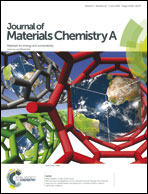A 3D nanostructure of graphene interconnected with hollow carbon spheres for high performance lithium–sulfur batteries†
Abstract
To better suppress the capacity decay over cycling and improve the electrical insulation of the sulfur cathode for lithium–sulfur (Li–S) batteries, we designed a novel three-dimensional nanostructure of graphene interconnected with hollow carbon spheres (3D rGO–HCS) as the sulfur host. The 3D rGO–HCS nanostructure was first prepared via a hydrothermal self-assembly method followed by carbonization and etching of the SiO2 core, then sulfur was impregnated into the nanostructure by an in situ solution deposition method to obtain the S@rGO–HCS cathode. The as-prepared cathode material delivers a high discharge capacity of ∼770 mA h g−1 at 4 C rate. More importantly, it has a high capacity retention of 93.9% after 100 cycles and demonstrates a low capacity-decay rate of 0.052% per cycle after 400 cycles at 0.5 C rate. The superior comprehensive electrochemical performance of the S@rGO–HCS cathode is ascribed to the synergic effects from the 3D graphene-network design, including fast electron and ion transportation, efficient confinement of polysulfide dissolution and shuttling and successful maintenance of structural integrity.


 Please wait while we load your content...
Please wait while we load your content...